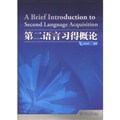 [内容简介]
[内容简介]
In recent twenty years, there has been a rapid development in the study of second language acquisition(SLA)both at home and abroad, which is partially the result of globalization, and, above all, the outcome of an increasing number of a second language learners. In line with this trend, China has incorporated a growing number of research centers and faculties engaged in the research of second language acquisition, and has also imported a large number of academic books on applied linguistics. However, these academic books do not seem to cater to the “mass market” of the universities of China, especially the largest population of undergraduate students majoring in foreign languages. A random survey may yield the possible answers: these books are too difficult in light of both concept and language. Students are daunted even when they start reading the first page.It is true that most of these books are written for researchers; Ithus they are mainly intended for careful perusal, but unsuitable for classroom instruction.
[目次]
Preface
Chapter One Understanding Second Language Acquisition
1.1 What is second language acquisition?
1.2 What are the objectives of SLA research?
1.3 Basic terminology in SLA
1.3.1 Native and target language
1.3.2 Second and foreign language
1.3.3 Bilingualism and multilingualism
1.3.4 SLA and foreign language learning
1.3.5 Input and output
1.3.6 Competence and performance
1.3.7 Usage and use
1.3.8 Comprehension and production
1.3.9 Naturalistic and instructed second language acquisition
1.4 The external and internal factors in SLA
1.4.1 External factors
1.4.2 Internal factors
Assignment
Chapter Two The Study of inter language
2.1 What is inter language?
2.2 Characteristics of inter language
2.3 Major findings in IL studies
2.3.1 Systematic changes in grammar
2.3.2 Acquisition order and sequence of acquisition
2.3.3 L1 influence
2.4 Inter language pragmatics
2.4.1 Second language speech act
2.4.2 Production of speech acts: differences between L2 learners and Ll speakers
2.4.3 Speech act research paradigm
Assignment
Chapter Three Linguistic Aspects of SLA
3.1 The nature of human language
3.1.1 Common characteristics of language
3.1.2 Different aspects of language
3.2.1 Contrastive analysis hypothesis (CAH)
3.3.1 Definition
3.3.2 Principles and parameters
3.3.3 UG and SLA
3.4 Typological universals:Accessibility hierarchy ( AH)
3.5 Functional approaches
3.5.1 Systemic linguistics
3.5.2 Functional typology
Assignment
Chapter Four Psychological Aspects of SLA
4.1 Language and the brain
4.2 Behaviorists' way of learning
4.3 Cognitive perspective of learning
4.3.1 Information processing (IP)
4.3.2 Connectionists'/ emergentists' models
4.3.3 Competition model (CM)
4.3.4 Bialystok's theory of 12 learning
4.3.5 Gass's integrative model of SLA
4.4 Individual differences
4.4.1 Aptitude
4.4.2 Age
4.4.3 Motivation
4.4.4 Cognitive style
4.4.5 Personality
4.4.6 Learning strategies
Assignment
Chapter Five Socio-cultural Aspects of SLA
5.1 Microsocial factors
5.1.1 Input and interaction
Chapter Six Instruction and Second Language Acquisition
Chapter Seven Second Language Acquisition Research: Data Collection and Analysis
References
An English-Clunese Glossary

 新书报道
新书报道